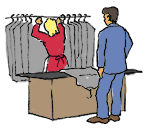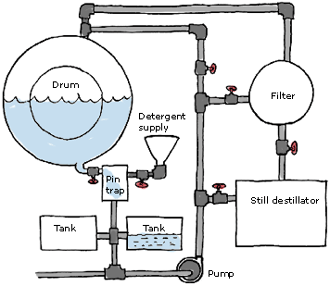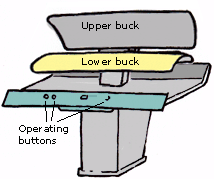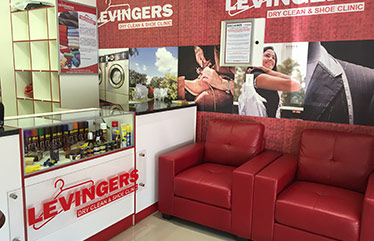Why’s And How’s Of Dry Cleaning
How Dry Cleaning Works
Dry-cleaning has long been the only alternative to traditional washing. There are several reasons for using dry-cleaning: Water-sensitive materials; Some linen cannot be washed in water; Some materials are very sensitive to water, and are thus often dry-cleaned, although today, wet-cleaning is a competitive alternative to dry-cleaning in some countries; Textiles with water-based colours may readily be dry-cleaned. Shrinkage Garments made from water-sensitive materials are often dry-cleaned to avoid or reduce shrinkage Preserved quality Dry-cleaning provides shape permanence and high finish. Folds and pleats are not damaged, while linings and the like will keep their stiffness. Furthermore, the risk of discolouration is normally negligible. NOTE: Materials containing PVC may be harmed during dry-cleaning. Solvents and the environment Today, two different solvents are in use for dry-cleaning: perchlorethylene (perc) and hydrocarbon. The timetable below shows the use of dry-cleaning solvents during the 20th century.
1950 The chemical used for dry-cleaning was white spirit 1960 Perc comes into use. It is a highly efficient chemical, although it harms plastic details. 1970 The chemical 113 is put into use for dry-cleaning delicate materials, thus complementing perc. 1990 113 is forbidden as it is discovered that the chemical damages the ozone layer. Instead, white spirit is refined, resulting in hydrocarbon. The Dry-Cleaning ProcessOne machine cleans and dries A dry-cleaning machine is basically a machine with built-in extraction and drying. A solvent other than water is used: most often perchlorethylene (perc). The solvent will remove fats and grease far more efficiently than a normal water/detergent liquid. Adding water However, the effect on water-soluble dirt and solid dirt is very low or even negligible. Consequently, to achieve an acceptable result, water must be added to the process. The water-adding procedure is, however, not quite so straightforward. If pure water was added, the result would be bodies of water unevenly spread on the solvent surface. The washing result would not be satisfactory. To spread the water evenly over the whole solvent surface, a detergent must be added to the water. Dry-cleaning detergents work in much the same way as water washing detergents, but are quite differently composed. The cleaning procedure includes:
The solvent Perc The most common solvent used to remove fats and grease is perc. Unfortunately, though, it is regarded as less friendly to the environment. The use of perc is the main drawback of the dry-cleaning process, and has recently caused alternative washing systems to be developed. Today, dry-cleaning remains the most common alternative to traditional washing. How Dry-Cleaning Works The illustration below describes the dry-cleaning process in a simplified way. Please note that a great number of different procedures exist on the market, and a certain method is very often connected to a manufacturer.
Drying process After extraction, the garments are dried by circulating hot air. The hot air blows onto the garments to remove most of the residual perc. This procedure is normally called deodorisation. The exhaust air from the machine contains some solvent, so it must pass an activated carbon filter before being transported into the open air. The evaporated solvent is separated from the air and fed to the distiller tank. The air circulates until no more solvent can be removed. Dry Cleaning Finishing & PressingTwo major steps The finishing process after dry-cleaning is divided into two major steps: first the garments are conditioned, then pressed. Conditioning The garments are conditioned, ?de-wrinkled?, on a steam air finisher. Different finishing-machines are used, depending on the type of garment. The dry-cleaning process utilises the following equipment for conditioning
Pressing Once the garment is conditioned, it is pressed. This is when the final appearance is achieved – creases are formed, seams, hems and panels are pressed. When finishing dry-cleaned garments, scissor presses and professional finishing tables are used. Spotting tables The spotting table is used to remove stains. Spotting tables always have a vacuum, both to draw through the liquid and hold the fabric in place. Generally, stains are removed before dry-cleaning in a pre-spotting process. During dry-cleaning, water-based stains and other difficult stains such as blood and ink will be removed. Spotting can also be done after dry-cleaning. This is called post-spotting. At this point, water-based stains and stains which were not discovered before the dry-clean will be removed. ?Post spotting? is usually carried out with a steam or water gun. Afterwards, the fabric is dried with an air gun. NOTE: Some stains not removed prior to dry-cleaning can sometimes be made more permanent during the cleaning process. Pressing Removes creases Soften the fabric.
Pressing can be carried out in a number of different ways depending on the type and quantity of items to be pressed. Small volumes of linen are most economically pressed manually, using a hand iron and an ironing table. A skilled person can hand iron up to 20 cotton shirts per hour.
Press bucks There are a variety of press bucks available – each buck is specifically made to fit a certain type or even a part of a garment. There are bucks suitable for collar and cuffs, trouser legs and tops etc. However, the most popular is a general purpose utility shape. Presses are mostly used in large on premises laundries and commercial laundries.
How press bucks works
Professional finishing table All garments can be pressed with a professional finishing table. This is equipped with an ?all steam iron? which is safe to use on dry work. A good hand steam iron is always supplied with a Teflon shoe which protects the garment. The large table always has vacuum which will hold the fabric in position on the table. The vacuum will also cool the garment after pressing. The vaccuum is also necessary for pressing light-weight fabrics and linings. Cleaning Labels All garments should have a cleaning label which indicates how the garment should be cleaned. It is important to Pay attention to the instructions and treat the garment accordingly. For a list of these labels go back to the main Menu to ?Cleaning Guides?.
|











